Systemic Design for Futures: Augmented with AI / Powered by human inquisitivity, creativity, sensemaking, and storytelling / Made for uncertainty.
Don't wanna be here? Send us removal request.
Photo
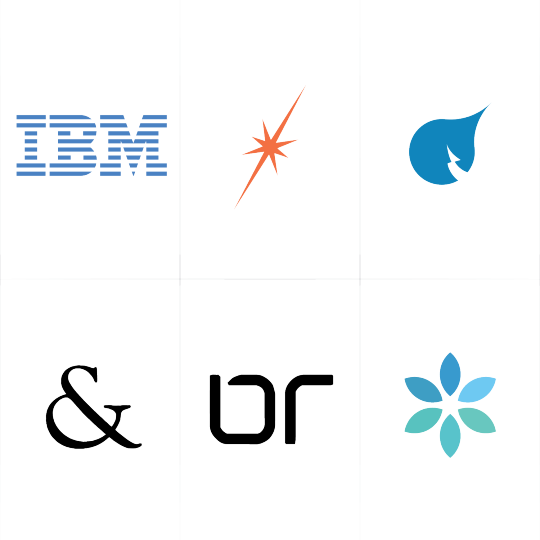
About Me
I’ve been articulating the future through creativity, design, foresight, and storytelling since 1991.
From small startups to large enterprises, my work has always thrived at the intersection of design and technology—whether crafting products, shaping strategy, or defining brands. I’ve led teams solving complex problems at scale at IBM, tackled product design with brutal honesty at Apple, performed in the theater of creativity at Saatchi & Saatchi, and fine-tuned micro-interactions at Organic and Blast Radius. As a co-founder, design became a tool not just for innovation, but for shaping culture. And on the experimental side, I’ve designed games that bring foresight methods to life—playfully exploring emerging futures.
From desktop publishing to the rise-fall-and-rise of the Web, mobile, and AI, my journey reminds me of Halt and Catch Fire. As technology perpetually transforms how we live and work, my design practice continues evolving with it.
Download my resume | PDF »
1 note
·
View note
Text
youtube
A Blueprint for Design
In this thought-piece, we explore the erosion of design’s perceived value in organizations—and why that’s a business risk, not just a creative one. Design needs to be integrated as a strategic function, accountable for both innovation and impact, that drives competitive advantage in today’s rapidly evolving world of technology.
#DesignLeadership#StrategicDesign#DesignThinking#InnovationStrategy#DesignAsStrategy#DesignMatters#UXDesign#BusinessDesign#ProductDesign#DesignForImpact#FutureOfWork#DesignInTech#CreativeLeadership#HumanCenteredDesign#DesignROI#DesignCulture#OrgDesign#Backcasting#DesignAndBusiness#DesignForChange#Youtube
1 note
·
View note
Text
youtube
↑ The Advanced Product Design Group was conceived in 2023 as a specialized team within IBM Software, intended to rapidly support and grow fragile, early-stage products—bringing structure, excellence, and accelerated impact much like a SEAL team—before handing off to long-term teams. This approach addresses a critical capability gap in a design workforce primarily focused on mature products.
IBM Data + AI Software

↑ Accelerating time-to-wow was its primary goal. This meant being able to very quickly articulate an abstract idea in tangible form, prove investment viability, and move it to the next stage.
↓ The team would specialize in sense-making, concept and futures design, storytelling, and stage-craft, then hand-off the product when it transitioned into full-development.
↘ Applying the 80:20 rule, the APDG would use only 20% of time, effort, and resources comparatively, to achieve 80% of a new product or feature's initial design.

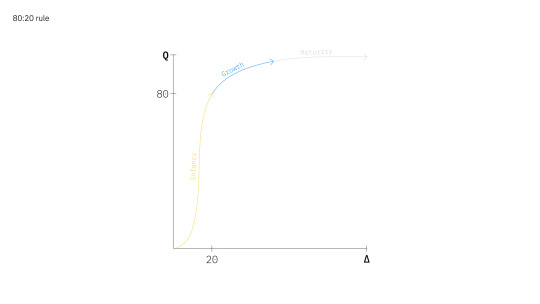
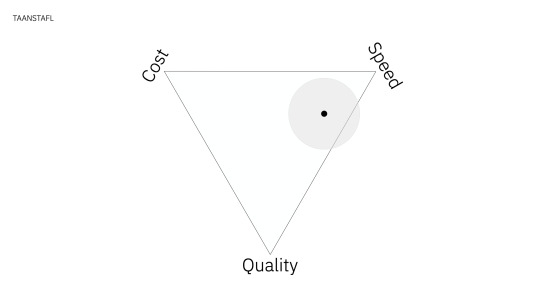

↑ Speed of execution would take precedence.
↗ As the APDG would consist of a very lean team, we would staff projects by augmenting existing product teams in a "triangle offensive", utilized in many consulting models, to enable cross-learning and interchangeability.
↓ I codified a system for quickly identifying designers by 6 temperaments, to most effectively match the right designers with the right projects.
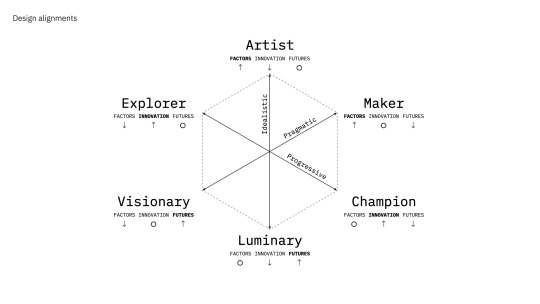
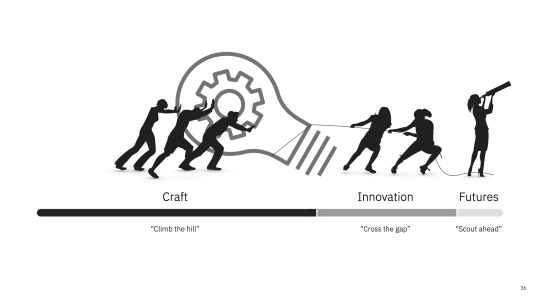
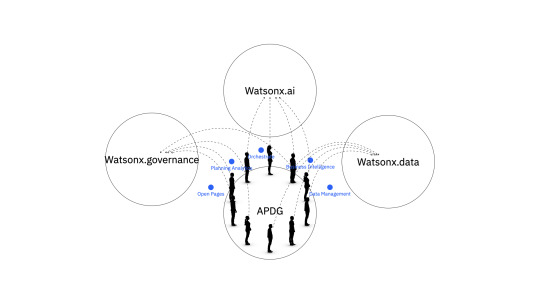
↑ The 6 temperaments align with 3 polyrhythmic trajectories of product development.
↗ APDG designers were deployed to 3 new watsonx AI initiatives to accelerate early-stage time-to-wow.
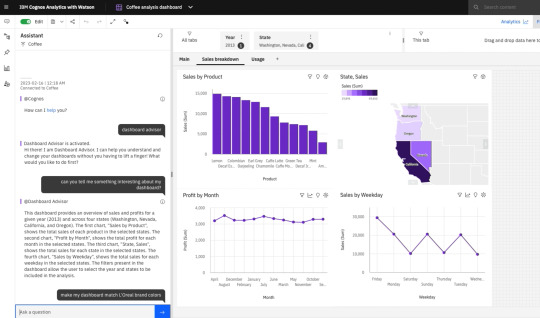
↑ While Cognos Analytics had already implemented an AI Assistant several years earlier, it was based on older rules-based models. Even though we updated the model later with one of our Granite large-language models, the "assistant" paradigm limited the type of experience that was possible with generative AI.
youtube
↑ The APDG was engaged to reinvent IBM's Business Intelligence platform for the AI era. Within 3 weeks of co-creation with stakeholders across 6 areas of the business—design, engineering, product management, sales, marketing, and research—we envisioned an AI-powered intelligent journal.
↓ The intelligent journal vision concept helped stakeholders acquire $5M initial round of funding to develop the watsonx BI Assistant. A private-beta was announced and demoed at THINK 2024, only 10 months after our concept.
youtube

↑ Our future roadmap, informed by the 3 Horizons foresight effort, and demonstrated with the announcement and private preview of watsonx BI Assistant, moved IBM from the niche to visionary quadrant in Gartner's annual report.
youtube
↑ The APDG was also engaged by Planning Analytics to discover user-needs based opportunities for AI. We facilitated an inside-to-out of the box innovation exercise with stakeholders from 6 areas of the business.
↓ This exercise lead to the invention of the Model Accuracy feature, which utilized AI to compare a TM1 or planning model to a natural language description of the intended business need or outcome.



vimeo
↑ In Fall 2024, I was tasked with a mission to define a POV for Design Telemetry, and build a new practice that could scale across the organization.
↓ Telemetry goes beyond product analytics: How might we create a real-time, adaptive system that integrates design intelligence, behavioral insights, and predictive foresight—enabling organizations to make proactive, future-proof design decisions that optimize both user experience and monetization?
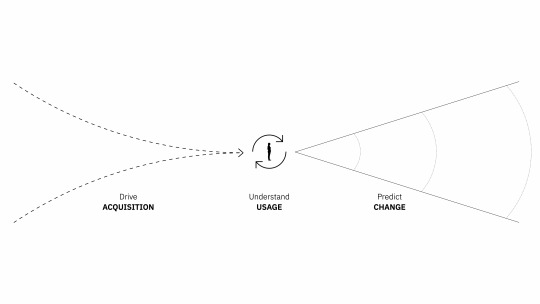
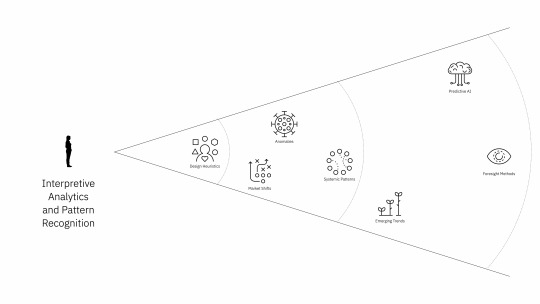
1 note
·
View note
Text
vimeo
Defining Design Telemetry
First part of 5 planned videos that proposes a point-of-view for applying Design Telemetry in IBM. It begins with defining a basis for what Design Telemetry is through its function, impact, and intended outcomes, as a quantifiable mechanism for foresight in product futures, and its proven use in industries such as video games.
1 note
·
View note
Text
youtube
watsonx BI Assistant
This is the new gen-AI product I envisioned and lead the experience for. watsonx BI Assistant brings extraordinary analytics powers to ordinary business users through the smartest reasoning engine we’ve ever made. It combines descriptive, diagnostic, and predictive AI tuned on the language and data of your business, to automatically model accurate insights with integrity, so you know what happened, why it happened, what will happen, and what you can do. Now everyone in your organization can harness this analytics brain to think, examine, discover, and transform—from inquiry-to-insight at the speed-of-thought.
0 notes
Text
youtube
Star Carriers · Edition 1
Star Carriers is a 4E (explore, expand, exchange, evolve) space strategy board game in which players venture to become the best interstellar carrier in the galaxy.
It's the culmination of about 6 years of design, development, testing, and manufacturing, with a limited production of 200 at the end of 2022.
Available from our online store: www.blitztream.com
0 notes
Text

↑ IBM Business Analytics defined and pursued an exciting roadmap to reinvention, largely through a close collaboration between design and product management. Lead by strategic design, we introduced frameworks such as Jobs-To-Be-Done, 3 Horizons, Value Proposition Canvas, and Design Envisioning Sprints for a portfolio of 4 flagship products: Planning Analytics, Cognos Analytics, Controller, and Open Pages. The outcome was to future-proof these products by integrating an end-to-end business performance management cycle for our customers, using emerging technologies such as AI where they made an impact.
IBM Business Analytics
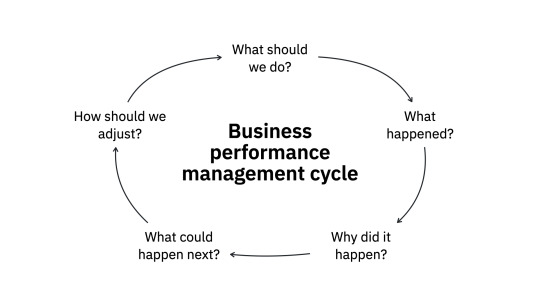
↑ The business performance management cycle for extended financial planning analytics, connects business intelligence and business planning together with data.
↓ Traditional business analytics solutions target 8-10% of an organization's technically advanced users, but knowledge workers represent 60% of xFPA consumption.
↘ Rising need for organizations to make better decisions quickly and easily from increasingly complex data requires us to rethink traditionally technical modes of BI tools.
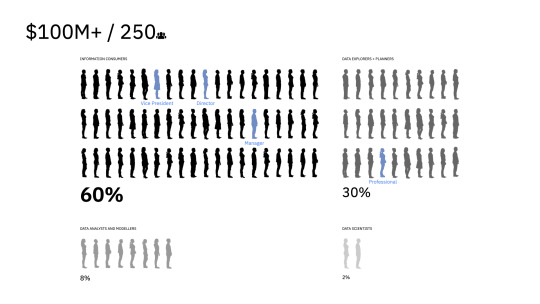
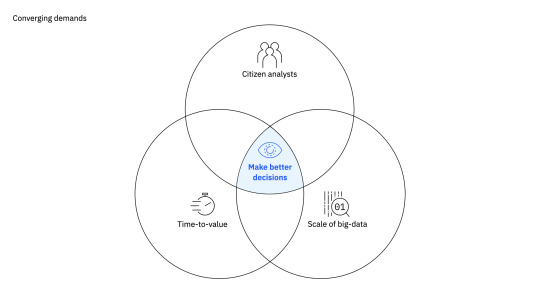
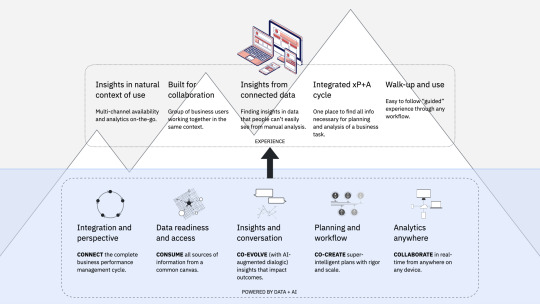
↑ Knowledge workers expect an xFPA experience considerably more approachable than existing systems, yet with the power to tap into deep organizational data.
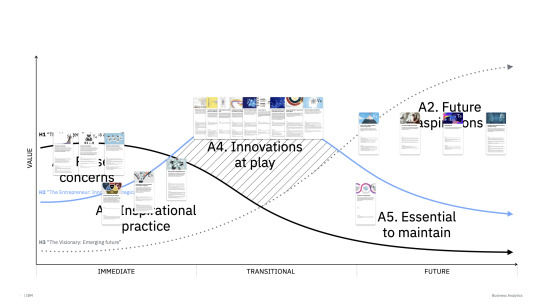
↑ The 3 Horizons foresight framework considers current, interim, and aspirational trajectories, which makes it particularly effective in business and enterprise contexts, where innovation has a polyrhythmic pattern.
↓ 19 relevant emerging trends and 5 key drivers were identified through horizon scanning and UX research data.
↘ Their impact on product trajectories was plotted together in a cross-functional workshop that included senior stakeholders from design, engineering, product management, sales, marketing, and research.

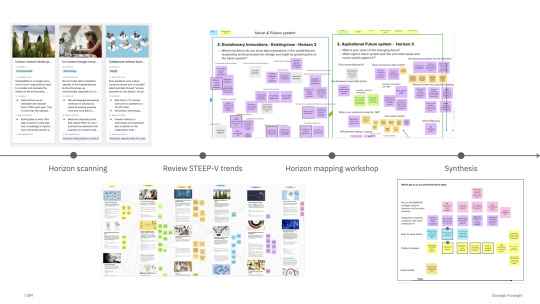
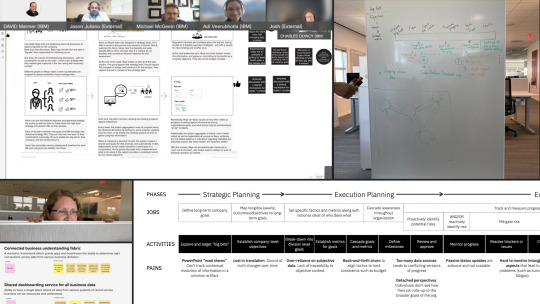
↑ Our envisioning sprints were a series of rapid collaborative design sessions in which we combined opportunities for under-served needs uncovered by Jobs-To-Be-Done, market and product analytics, and emerging technologies along 3 Horizons, to creatively envision use cases that could then be wind-tunneled and validated against our Value Proposition Canvas.
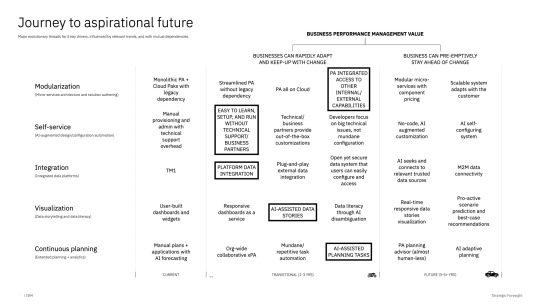
↑ New capabilities, and advances to existing ones, were proposed for near (skateboard), mid (bike), and long (car) development roadmaps.
↓ We identified current capabilities and technologies that would remain essential vs those that should eventually be deprecated.
↘ And anticipated tension points that require non-zero-sum strategies.
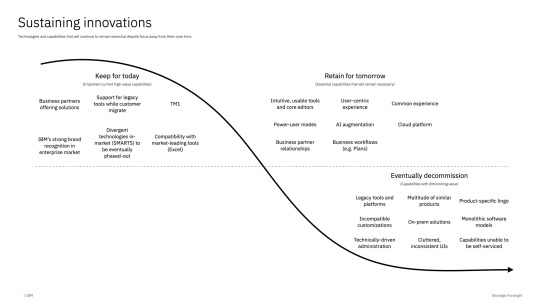
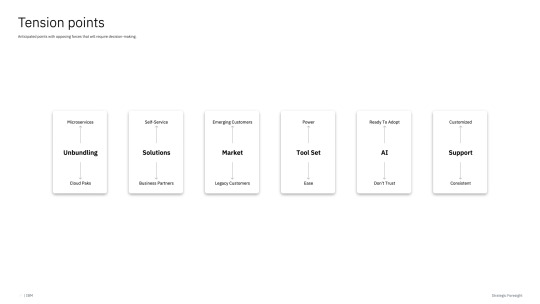

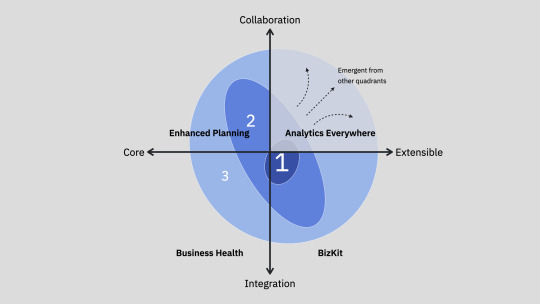
↑ Our product innovation strategy addressed 4 areas from core collaboration to an extended integration ecosystem.
↗ With a go-to-market in 3 phases, beginning with modularization of our products into a composable services architecture that can be connected in different ways to create an end-to-end business performance management cycle.
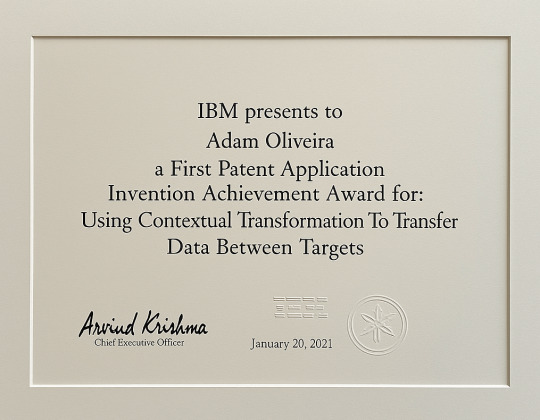
↑ An invention achievement for a patent I filed that addressed an interesting problem for users when working with common information across multiple applications in an integrated ecosystem. The patent proposes a method of copy-and-paste that uses AI to understand context of the transfer and modify the pasted content appropriately. For example, if copying and pasting data from one currency or language to another document in another currency or language.
↓ The patent was granted in 2021 and published in 2022. Read the full publication here »

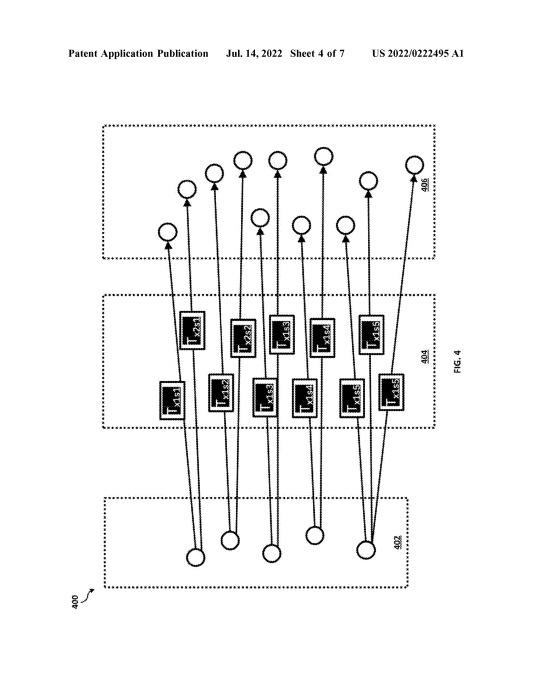
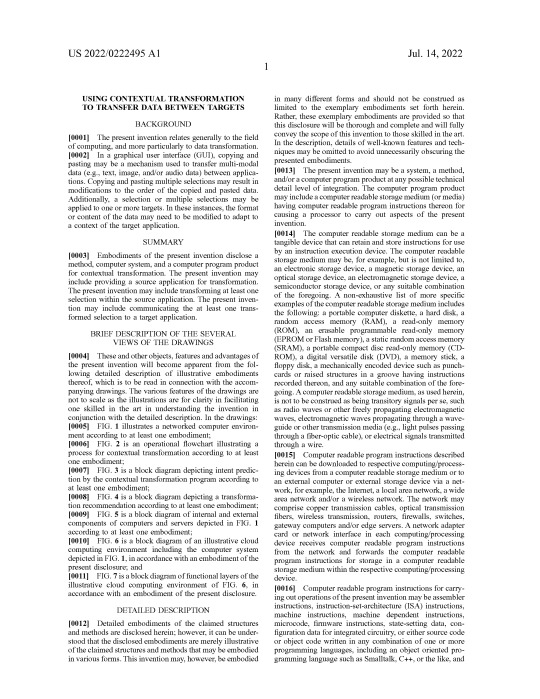
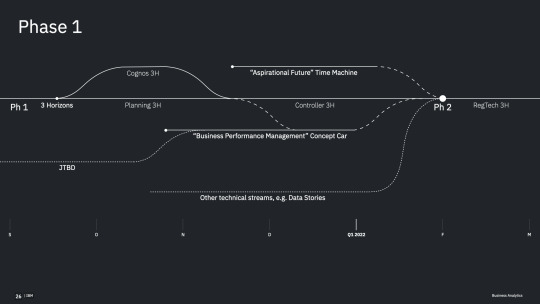
↑ The master plan involved conducting similar rigor on all 4 products, and converging existing streams of product development.
The strategic design work for reinventing IBM Business Analytics lead directly to the creation of the Advanced Product Design Group (APDG), and subsequently several new watsonx initiatives, including watsonx BI Assistant, which are covered in the next chapter on IBM Data + AI.
0 notes
Text

↑ Modernizing Planning Analytics, which traces its origins back to 1983, began with an end-to-end overhaul of the UX, adopting IBM's Carbon Design System and Cloud platform. Improving and accelerating time-to-value was the primary impact we were pursuing through modernization.
IBM Planning Analytics
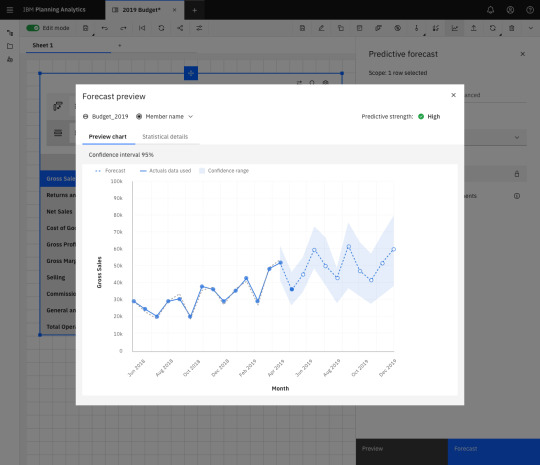

↑ Predictive forecasting, and ↗ no-code plan building, were two major new innovations we added to Planning Analytics.
youtube
↑ Predict On-Demand demoed at THINK 2020. Users could easily and quickly perform predictive forecasts in the visual Planning Analytics Workspace (PAW) environment.
↓ Plans+Apps also introduced and demoed at THINK 2020. Users could now build plans from starter templates in a no-code visual workflow UX.
youtube

↑ CoSTA (Cognitive Spreadsheet Transformation) was a pilot research project in partnership with the UK Government and University of York that experimented with machine learning to intelligently convert Excel spreadsheets into a TM1 model. It paved the way for subsequent innovations using Watson AI.
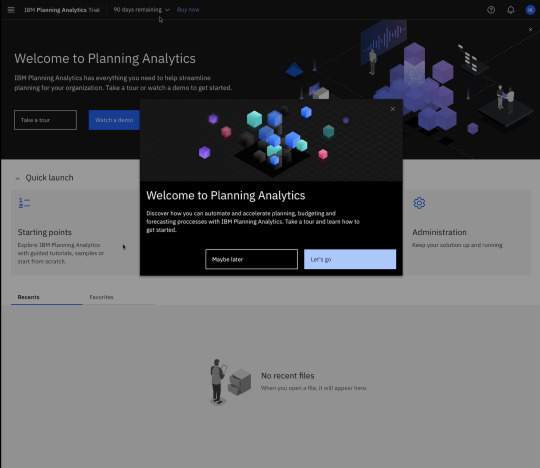

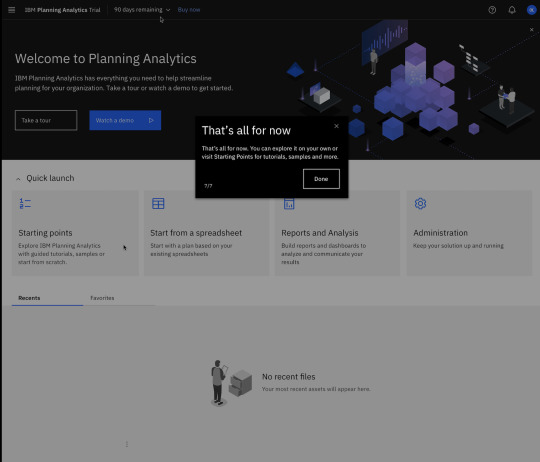
Guided contextual help, using WalkMe, was a simple, but essential UX feature we implemented.
youtube
↑ Watson Moments was IBM's initial implementation of passive AI, pre-dating Apple Intelligence by several years. This example uses AI to detect outliers in complex data, which it can also help correct.
↓ This example uses AI to identify and conduct root cause analysis of anomalies in complex data.
youtube

↑ Modeling Workbench introduced an enhanced visual UX for building multi-dimensional data models.

↑ Product roadmap shows all innovations and initiatives my design team were actively engaged in.
0 notes
Photo
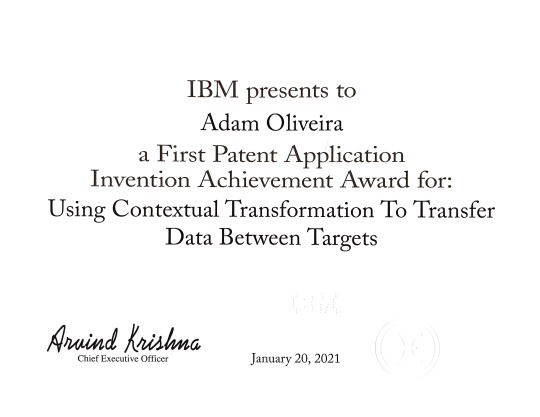
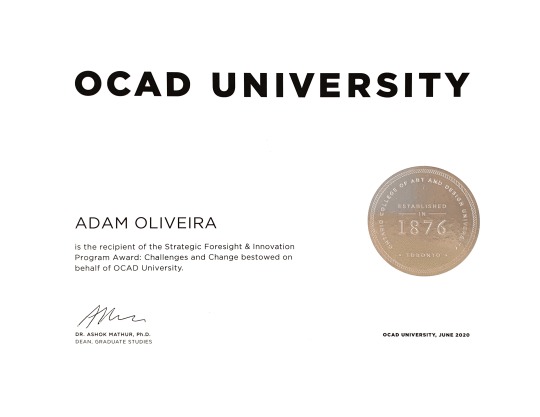
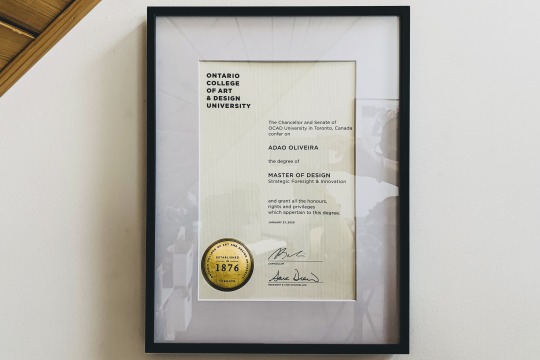
MDes · Award · Patent
Two more pieces of fancy wallpaper I need to get framed in addition to my MDes. The first is my First Patent/Invention award from IBM. The second is a grad award for Strategic Foresight + Innovation: Challenges and Change, nominated by my prof and advisor Dr. Peter Jones. Thank you IBM and OCAD University for the recognition!
0 notes
Video
youtube
How Mutable is the Future?
Can long futures be adaptively transformed by choices and decisions in the face of indomitable challenges?
This major research project for my Master of Design explores human capacity to create our future through the lens of complex systems and foresight. We designed a cooperative board-game about off-world colonization as an interactive platform for testing the effects decisions have on large-scale, long-time-frame challenges, and whether civilization has the ability to steer the outcomes.
Explore the project at Cosmic Labs »
#design#future#foresight#systems#space#colonization#interstellar#space travel#space flight#extraterrestrial#offworld#game#board game#cooperative
0 notes
Photo
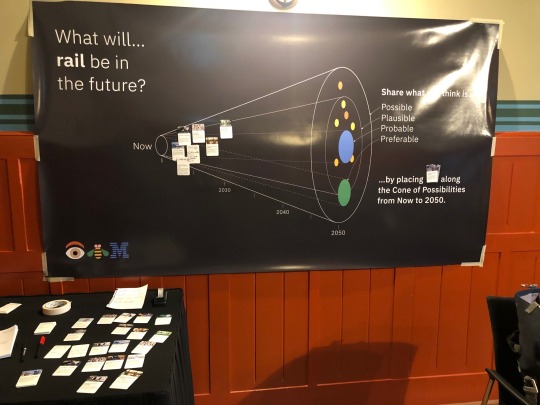
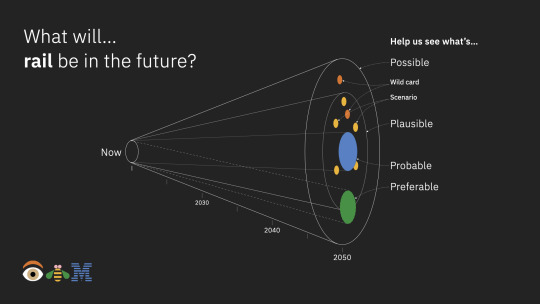
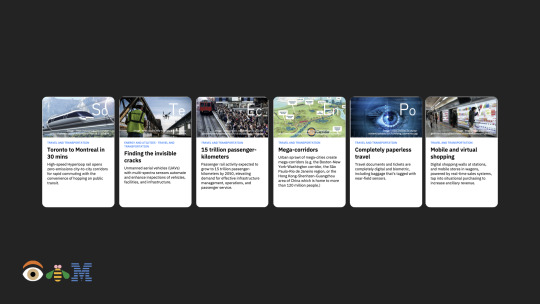
The Future of Rail
For the 2019 World Rail Conference, IBM’s Travel & Transportation industry asked me to reprise a futures exercise that could engage attendees while also testing the probability of emerging trends. I proposed using the Cone Of Possibilities, with a collection of trend cards we researched ahead of the conference, that attendees could apply to the Cone where they expected it would most likely mature. The results became useful inputs for the Rail team’s subsequent strategic roadmap planning.
0 notes
Text
youtube
Enterprise Futures
My presentation at our second aviation industry conference in 2019 on the impact and outcomes of futures work we've been doing with our airline clients.
0 notes
Photo
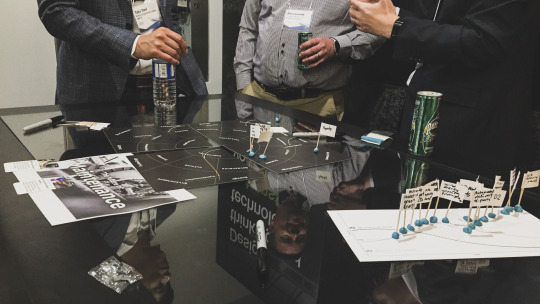
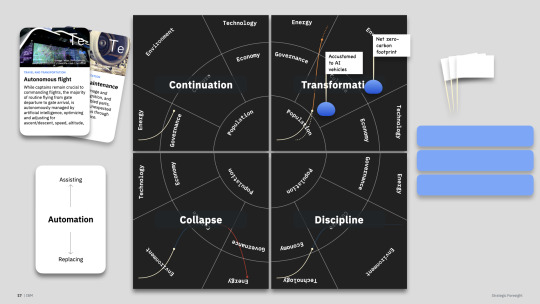
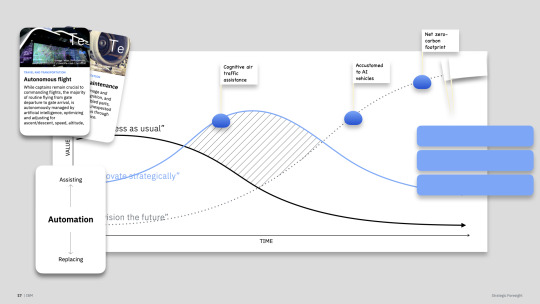
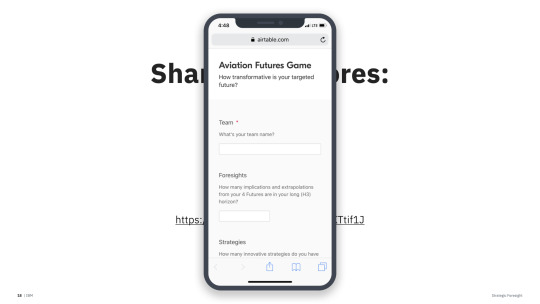
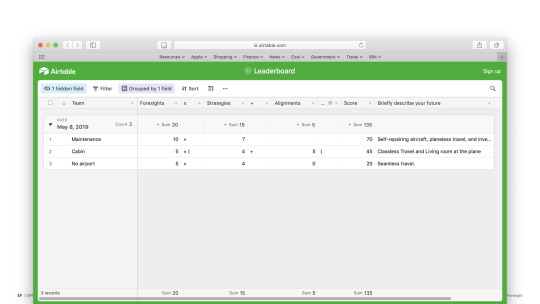
Aviation Futures
To demonstrate how foresight could be effectively workshopped at IBM’s 2019 Aviation Summit, I designed a game based on Dator’s 4 Futures and 3 Horizons, and facilitated the exercise through Design Action Research. Essentially using the game board and pieces as the canvas for mapping emerging trends, and then creating a simple scoring system in Airtable that could track progress on participants smart phones to encourage coopetition between teams.
0 notes
Video
youtube
To Boldly Go
The intrinsic human need to explore, discover, and conquer new frontiers saturates every domain, from sports to science. By far the most daunting of these domains, whether material, physiological, or intellectual, is interstellar space. Although still at least 100 years away from viable commercial space travel to Mars, the entities with the means to drive this pursuit remain vigilant despite popular wisdom. It is a pursuit that requires a non-zero-sum game, a Systems Thinking perspective of global cooperation and mutual gain. Technology, policy, and social advancements born out of space travel may provide the answers to some of Earth’s most pressing problems. The challenge has been to inspire the vast majority of people to look upwards again after decades of fixation on the current world condition. Media and entertainment play significant roles in influencing attitudes and world views, and games in particular can offer ways to explore complex multidimensional ideas in simple and fun ways. By combining gaming and systems concepts, Interstellar, explores the social and ethical plateaus that challenge our evolution toward a unified space-going species through a compelling multiplayer board game. By balancing the causal, and contradictory, relationships between military, civilian, commercial and scientific interests, the game lets players explore the dynamics between cooperation vs competition, and their effects on advancing civilization into Space.
0 notes
Text

↑ The Apple | IBM MobileFirst program, announced by Ginni Rometty and Tim Cook, was an ambitious partnership to combine IBM's deep domain knowledge in enterprise systems with Apple's iOS platform and user experience to create 100 best-in-class solutions for mobile-oriented design problems by the end of 2015.
| IBM MOBILEFIRST
youtube
↑ I gave this internal presentation back in 2017 at the peak of the | IBM MobileFirst program. Two years into both the creation of IBM Design and this unlikely partnership, it was a very exciting period of design at IBM, during a very innovative period in technology.

↑ One of this program's key value propositions was our Enterprise Design Lab, a 3 day rapid co-design accelerator, in which we began by a deep-diving into the end-users day-in-the-life, workshopping the experience, and finishing with a high-fidelity prototype.


↑ One of my early workshops with JAL for their aircraft mechanic app, called Inspect + Turn, in the original Enterprise Design Lab on North Tantau, Cupertino.
↗ The second day involved an iterative cycle of whiteboard wireframes, where the design team would sketch and capture designs into an animatic, and playback to participating end-users, with a willingness to throw-away and rethink.



During the 8-14 development, we continued to test and refine our design, often on-site in the end-users real-world environment.

↑ Asset Care was an iPad app designed for excavators, to map and track deforestation, so vegetation and terrain could be restored after they had finished. Our participating German end-users didn't speak English well, so we eventually realized we needed to present our designs in their language.


↑ The main hallway inside IBM Almaden Research Center with the end-to-end mural of IBM's invention history, that includes its first patent for the meat slicer in 1911, Fortran, the Apollo Program, and quantum computing.
↗ Giving a talk on creativity to a group of researchers at IBM Research.



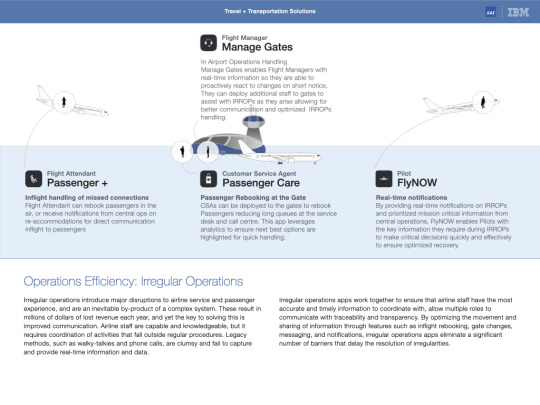
Our Travel + Transportation suite was the most complete set of enterprise iOS apps, and by 2017, covered end-to-end operations for airlines.

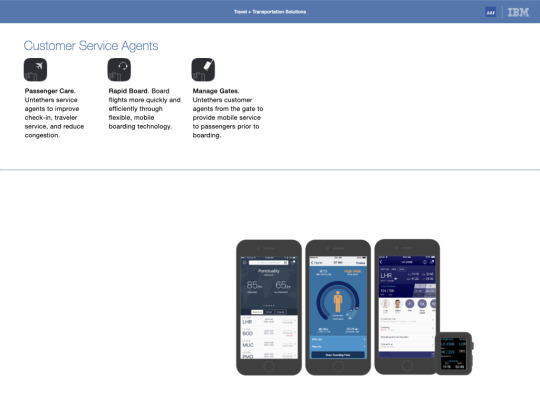

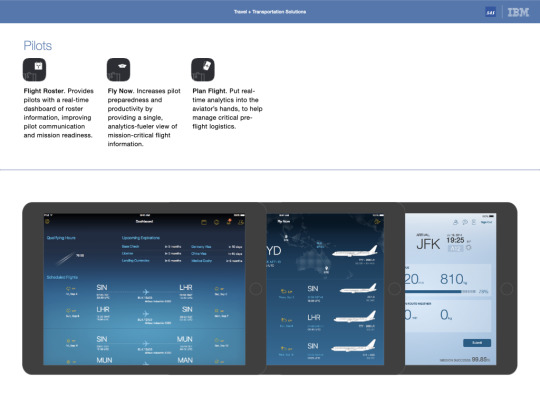
The apps were targeted at 4 primary roles, enabling them to have real-time untethered access to centralized mission-critical operational data.
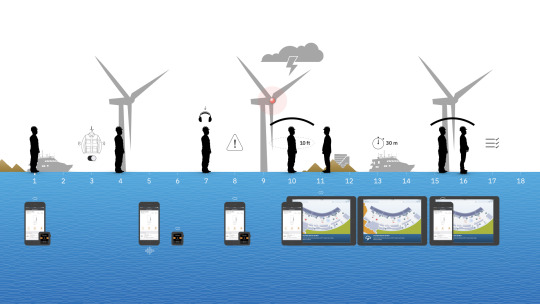
Our Energy + Utilities suite was not as extensive, but combined a series of apps for renewable energy workers.

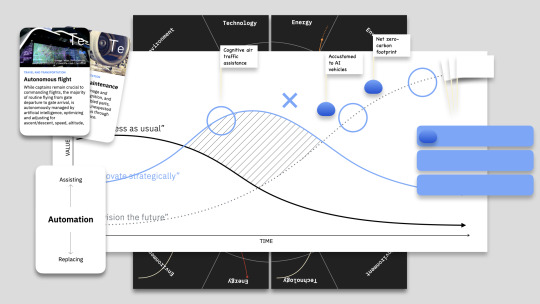

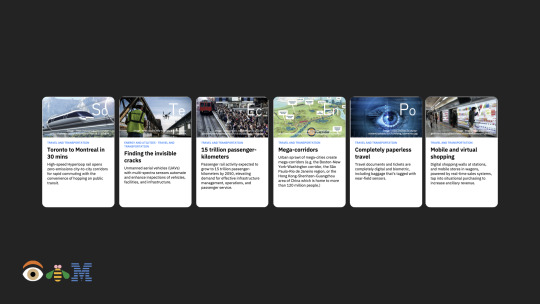

From 2017, we began to push innovation further with strategic foresight, exploring the future of travel, and working with Apple on designing solutions using emerging technologies such as point-to-point networking, AR, and AI.
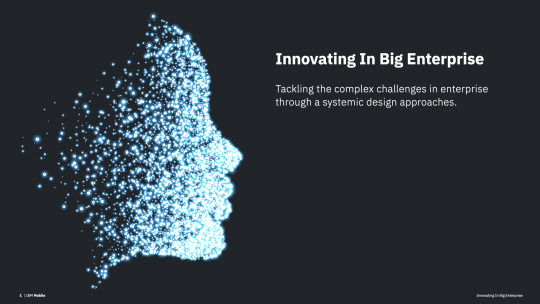

↑ My talk on Innovating in Big Enterprise at our 2018 Aviation Summit covered a broad range of design-oriented practices and methods for driving and realizing innovation.
↗ Followed-up next year with a talk on Enterprise Futures, using strategic foresight to detect, discover, and predict emerging signals that influence or help to define product and business roadmaps.

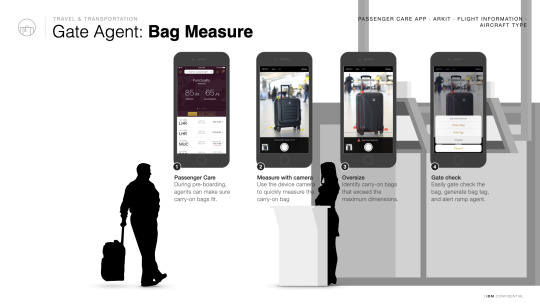
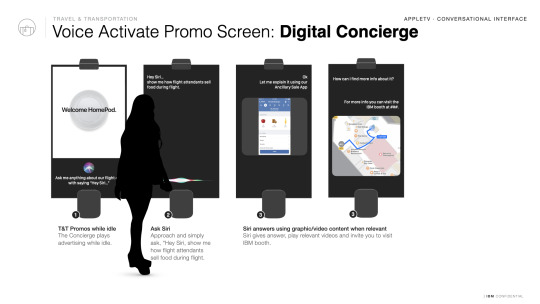
↑ These were demonstrated in new apps for in-cabin collaboration, baggage gate-checks, ramp loading, and airport customer service.
↓ We even time-machined the future experience at the the T+T innovation fair in Abu Dhabi.

0 notes
Text
youtube
Innovating in Big Enterprise
My presentation of applying strategic foresight and innovation for our aviation clients from Mar 2018 Aviation Industry conference.
0 notes
Video
youtube
| IBM MobileFirst
IBM approached me in Dec 2014 through a referral. They were looking for someone who could lead and be transformative, knew product development, UX, mobile apps, and what Apple's design philosophy was all about. Creating awesome iOS apps for specialized industries, lots of travel to Cupertino, and change the way people do things - seemed like a match made in heaven. I was onboarded by Feb 2015, and by March was at Apple's Enterprise Design Lab combining Apple's hardware with IBM's cognitive and analytics services.
It continues to be one of my favorite roles. We launched 100+ apps in a year. Utilized device sensors, location, voice, 3D Touch, Watson cognitive computing, big data analytics, and more. The apps work for pilots, mechanics, miners, bankers, law enforcement, drivers, healthcare professionals and other enterprise users, and do things like diagnose engine problems via vibrations and sound, calculate aircraft fuel for flight paths, detect hazards in mines, capture conversational data, annotate over images, predict outcomes, and display custom terrain maps. They run on iPad and iPad Pro, iPhone, and Watch
See the apps here: http://www.apple.com/business/mobile-enterprise-apps/
0 notes